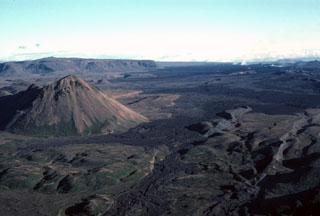Report on Krafla (Iceland) — February 1981
Scientific Event Alert Network Bulletin, vol. 6, no. 2 (February 1981)
Managing Editor: Lindsay McClelland.
Krafla (Iceland) Fissure eruption and intrusion end; inflation resumes
Please cite this report as:
Global Volcanism Program, 1981. Report on Krafla (Iceland) (McClelland, L., ed.). Scientific Event Alert Network Bulletin, 6:2. Smithsonian Institution. https://doi.org/10.5479/si.GVP.SEAN198102-373080
Krafla
Iceland
65.715°N, 16.728°W; summit elev. 800 m
All times are local (unless otherwise noted)
"The initial vigorous phase of the eruption lasted until the early morning of 31 January. Then activity began to decrease, with shortening of the crater row that initially extended 2 km, then decreasing activity in the craters and declining lava production.
"The final activity in the craters died out just after 1400 on 4 February. During the eruption, slow deflation over the Krafla magma reservoirs, 8-9 km to the S, was observed, but inflation started again at about the same time as the eruption ceased. The lava covered 6.3 km2 and appeared to be similar in volume to the two previous eruptions in July and October 1980 (5:7,10).
"Considerable movement of faults extending about 1 km N of the main lava (~8 km N of the craters) was observed. Large volumes of steam emitted from these faults suggest that lava again forced its way down into the faults and then northward. Renewed earthquake activity in this region on 1 February was possibly associated with this fault movement.
"By early March the inflation of the magma reservoirs had regained over half of the deflation that accompanied the eruption. Experience indicates that previous ground levels will be reached about the end of March to early April."
Geological Summary. The Krafla volcanic system in the Northern Volcanic Zone (NVZ) of Iceland is about 100 km long, consisting of a fissure swarm and a central volcano with a 7 x 9 km caldera formed about 110,000 years ago that deposited a rhyolitic welded tuff. It has been moderately active in the Holocene, over three distinct eruptive periods; the current one has lasted about 2,800 years with six volcano-tectonic episodes, each with one or more basaltic fissure eruptions. Lava volumes (DRE) have been in the 0.1-1 km3 range. The Hverfjall and Ludent tuff rings east of Myvatn were erupted along the fissure system. Myvatn lake formed during the eruption of the older Laxarhraun lava flow from the Ketildyngja shield volcano of the Fremrinamur volcanic system about 3,800 years before present (BP); The present Myvatn lake is constrained by the roughly 2,000 years BP younger Laxarhraun lava flow from the Krafla volcanic system. The abundant pseudocraters that form a prominent part of the Myvatn landscape were created when the younger Laxarhraun lava flow entered the lake. The last eruption took place in 1975-1984 CE when nine small basaltic fissure eruptions produced 0.25 km3 of lava.
Information Contacts: K. Grönvold, NVI.

